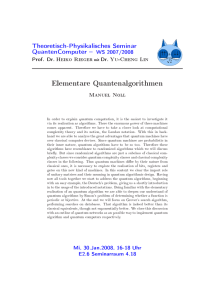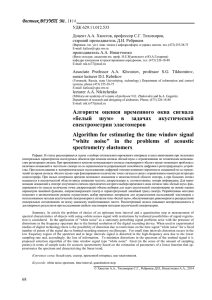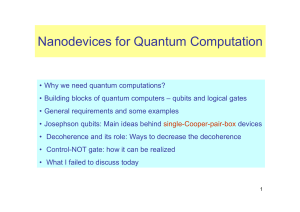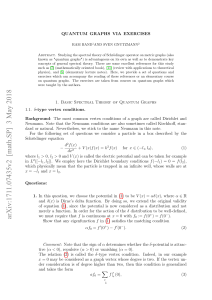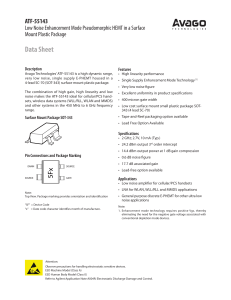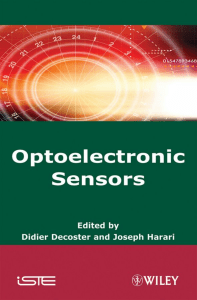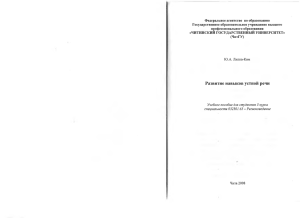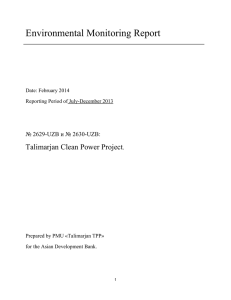GaAs/InGaAs/GaAs quantum well with remote Mn delta
реклама
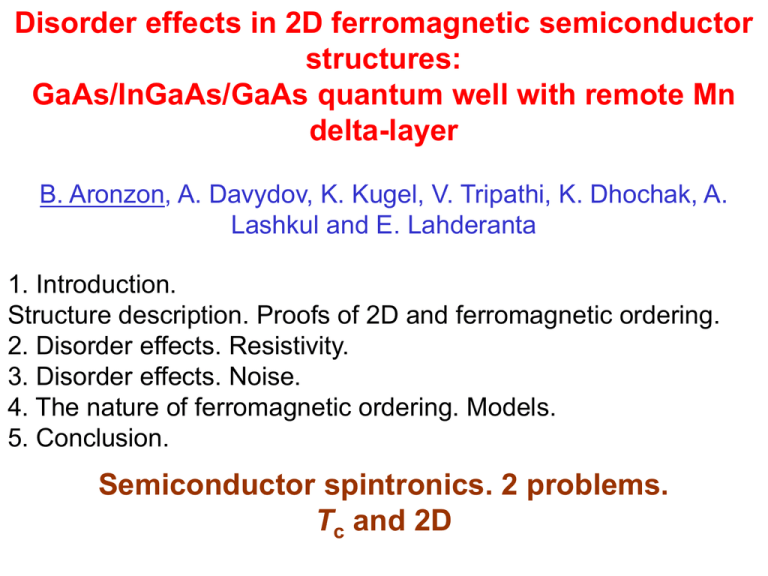
Disorder effects in 2D ferromagnetic semiconductor structures: GaAs/InGaAs/GaAs quantum well with remote Mn delta-layer B. Aronzon, A. Davydov, K. Kugel, V. Tripathi, K. Dhochak, A. Lashkul and E. Lahderanta 1. Introduction. Structure description. Proofs of 2D and ferromagnetic ordering. 2. Disorder effects. Resistivity. 3. Disorder effects. Noise. 4. The nature of ferromagnetic ordering. Models. 5. Conclusion. Semiconductor spintronics. 2 problems. Tc and 2D 2Dcap-layer GaAs, 30-40 nm -layer Mn spacer GaAs, 3 nm QW InGaAs, 9-10 nm GaAs, 15-18 nm -layer С Buffer layer GaAs, 0.5 μm Substrate i-GaAs (100) Quantum well with Mn delta layer Awshalom et al., 2004 Zaicev, et al., 2009 Aronzon et al., 2006, 2009, 2010, 2011, 2012 Wegscheider et al., 2007, 2010 Dietl et al. 2010 Sapega et al. 2012 B.N. Zvonkov et al. N. Novgorod cap-layer GaAs, 60-80 нм δ-layer Mn spacer GaAs, 1-5 нм QW InGaAs, 9-10 нм GaAs, 5 нм δ-Be Buffer GaAs, 25 нм Substrate GaAs, (100) Y. Furdyna et al. Buffalo Parametes of the samples 2 25000 T=5K B _I_ xy 40 Rxy, KOhm 20000 Rxx, Ohm Quantum Hall Effect 2D 15000 10000 InGaAs/GaAs QW 30 2 Rk = h/e 20 10 5000 0 -12 -8 -4 0 4 8 12 0 10 B, T 15000 T=5K 14800 B in plane 14600 0 4 8 B, T 12 20 30 GaAs(Mn)/In0.17Ga0.83As/GaAs Mn 0.5ML Rxx, KOhm Rxx, Ohm 15200 B, T 40 d=10nm, 11 -2 ns = 4.56*10 cm 20 0 J. Appl. Phys. 107, 023905 (2010) 10 20 B, T 3 Transport proofs for ferromagnetism Resistivity ? Metal - insulator transition under rise of Mn content ? Anomalous Hall effect Hall resistance dependes on spin-orbit interaction and carrier polarization RHd= yx = R0B + RsM Pure carbon doping (Sample 5) shows no resistance anomaly. Samples 1 and 4 show hysteresis in magnetisation curve. [ JETP Lett. (2008)] Anomalous Hall effect observed in all samples doped with Mn. Fluctuation potential After Gergel’ and Suris paper and Shklovskii and Efros Formation of charge carrier puddles in the quantum well (QW) from competition of doping disorder and nonlinear screening. z0 Location of holes in the transverse direction Hole wavefunction in transverse direction Typical potential fluctuation Vfluc Partially ionized Mn dopants Schematic of the quantum well potential (shown inverted). Dashed (blue) line represents the quantum well potential in the absence of fluctuations and the solid (red) line shows the potential well with an attractive fluctuation potential. The dotted line indicates the Mn dopants at a distance from the left face of the quantum well. Model of nanoscale inhomogeneities RMS potential fluctuation: V fluc z = e z0 2 z Rc 2 n' a e 2 log 1+ 2 2 16 0 + z [Kennett, Tripathi, PRB (2006)] Screening length n’a - Density of ionized Mn corresponds atoms to carrier density p: Rc = PRB, 2011 n' a / p Electrical resistance: Role of ferromagnetic correlations EA + J(1-cos θi j ) Vb a θi j rrier Di j i j Extra energy cost due to spin orientation T = ρ0exp E A / T + J 1 cosθij / T ρ PRB, 2011 cosθ ij = exp Dij / ξ M Cosine term changes appreciably when magnetic correlation length becomes of the order of droplet separation. Resistivity anomaly corresponds to rapid change of magnetic contribution. Resistivity PRB, 2011 Two phase system Tc Tс – local transition in magnetic islands Observed temperature dependence of resistance for (a) Sample 4, in units of the resistance at 70 K, and (b) Sample 1, in units of the resistance at 90 K (points), and theoretical fits (solid lines). Sample 4 is near the percolation threshold and Sample 1 is well-insulating. The fits were made using Eq. (13). Parameters such as the activation energy EA and the droplet separation D1 were chosen close to the values obtained from the droplet model. The magnetic parameters J and TC were then varied to obtain the above fits. In both cases, the best fit value of TC was significantly larger than the temperature, at which the resistance anomaly (hump or shoulder) was observed. Power Spectal density x frequency -1 Power Spectral Density (Hz ) Power spectral density of electrical noise 1E-13 1E-14 at 10Hz 1E-15 at 150Hz 1E-16 10 100 T (K) 1E-12 1E-13 1E-14 0,1 10 100 1000 frequency, Hz 23K 4 2,0x10 1 0 1 2 3 4 5 1 2 3 4 5 Rxx, Ohm 22.6K 21.4K Percolation transition in magnetic subsystem? 4417 10 20 30 40 50 T, K 60 70 80 90 1 2 3 4 5 0 1 2 3 4 5 0 1 2 3 4 5 0 1 2 3 4 5 0 1 2 3 4 5 0 1 2 3 4 5 0 1 2 3 4 5 0 1 2 3 4 5 20.9K 4 0 0 0.15 21.5K 1,5x10 There are no transitions in transport properties. 0 20.6K 20.3K 20.1K 18.94K PRB, 2012 18.94K 9 Noise fit: Frequency dependence The long-time dependence of the resistivity autocorrelation functionSρ(t) extracted from the noise data at T = 4.0 K together with fits. The red curve is a fit to Sρ(t)=A/t1.05 + Bln(t/t0), blue curve is a fit to Sρ(t) = A/t2/5 + Bln(t/t0). In 2D, Sρ(t ) ∼ t−1 behavior is expected for a disordered RKKY ferromagnet and Sρ (t ) ∼ t−2/5 for doubleexchange ferromagnets. The logarithmic time dependence indicates 1/f noise contributions. The fit to the RKKY model is better than to the double exchange. Frequency dependence of noise at T = 4 K (solid curve) together with fits to the low- and high-frequency regimes. At the low-frequency end, the dashed curve and the dotted curve are fits to Sρ ∼ A − Bf2 and Sρ ∼ A − B lnf − Cf, respectively. At the high-frequency end, the fit is to Sρ ∼Af−1.53. PRB, 2012 Sρ f ~ f 1.53 10 Noise fit: Temperature dependence Sample 4 f = 150Hz S f ~ Fit to TC= 52K PRB, 2012 2 Tc e /T Curie temperature dependence on the depth of quantum well 0,6 max z 40 Mn 0,25 MC Mn 0,3 MC 55 and 57 set 5763 5569 0,4 0,2 30 5765 0 20 -4 -2 0 40 10 110 meV 5764 Mn GaAs GaAs 0 U=100 meV 80 2 4 6 q 0z 5572 GaAs U=140 meV U=180 meV 100 120 140 160 180 E, meV J. Phys. Conf. Ser. 2013 48 set Mn 0.5 Ml 4843 35 4832 -4846 Tc, K Tc, K 5570 15 10 5 u0=3 30 4831 4836 25 4834 20 0.10 0.15 E, eV 0.20 Curie temperature dependence on the spacer thickness Mech cap-layer GaAs, 30-40 nm cap-layer GaAs, 60-80 нм -layer Mn spacer GaAs, 3 nm δ-layer Mn spacer GaAs, 1-5 нм QW InGaAs, 9-10 nm QW InGaAs, 9-10 нм GaAs, 5 нм δ-Be Buffer GaAs, 25 нм Substrate GaAs, (100) GaAs, 15-18 nm -layer С Buffer layer GaAs, 0.5 μm 32 Substrate i-GaAs (100) 30 26 24 22 MBE Tc, K Tc, K 30 CVD 28 5574 Mn 0,3 In 0,3 1 5570 Mn 0,3 In 0,3 2 3 d, nm 5575 Mn 0,3 In 0,3 4 5 25 1 J. Phys. Conf. Ser. 2013 2 3 d, nm 4 13 5 Models Mn Itinerant FM ordering in GaMnAs layer. (S.Caprara et al. PRB (2011)). M=0 Averkiev et al. – resonance tunneling. PRB (2012). GaMnAs GaAs GaInAs Meilikhov et al. – overlapping of the wave function tails with GaMnAs layer. JETP Letters (2008) Two phase system Tс – local transition in magnetic islands EF Tc L Mn layer – GaMnAs GaMnAs GaAs GaInAs Conclusion Disorder and magnetic interactions affect strongly both transport and magnetic properties of the structures and could explain the temperature dependence of resistance and noise quantitatively. THANKS FOR YOUR ATTENTION! 15 Model of nanoscale inhomogeneities z0 Assume Gaussian white noise distribution for ionized dopants: nr nr' n 2 = n' a r r' Fluctuation charge in circle of radius R: nR 2 = Disorder screened by holes in QW: PRB, 2011 p= n' a R 2 nR 2 = n' a / / Rc Ferromagnetic correlations: models I. Isotropic 2D Heisenberg ferromagnet H = J Si S j No long-range magnetic order at finite temperature. ij a / 1 Tc / T , T ≫Tc ξ = M aexp Tc / 2T , T Tc II. Uniaxial 2D Heisenberg ferromagnet H = J Si S j K S jz 2 ij T0 ~ i Tc ln 2 J / K M. Bander, D. Mills, PRB (1988) a / Tc T , T ≫Tc ξ T0 T Tc M = aexp Tc / 2T , γ a / 1 T / T , T ~ T 0 0 = 1.25 for Ising Voltage noise: magnetic fluctuations Resistivity noise from magnetic fluctuations 2 S ρω / ρ J / T 2 Dij / ξ M C 0, ω + e C D , ω , αα αα ij α Cαβr, = αβ 2T d q e 2 iqr Im αβq, Autocorrelation function of magnetisation Autocorrelation function contains information on dynamics, and can shed light on the mechanism of ferromagnetism. Magnetic correlations: dynamics αβ 0 T Resistivity noise is sensitive to αβ q, = 2 1+ q M i / q, the dynamics of the ferromagnet: Interested in two broad universality classes depending on whether the dynamics has a hydrodynamic description: Model A: No conserved order parameter e.g. anisotropic Heisenberg q, Model B: Conserved order parameter e.g. Isotropic Heisenberg q, Hohenberg, Halperin, RMP (1977) 2 = const. / M q,ω0 2 = Dq q,ω0 2D X-ray diagnostics of the samples a/a, % 4 InхGa1-хAs 0.3 2 4831 (GaAs)1-yMny 0.1 0 J. Appl. Phys. 107, 023905 (2010) -layer Mn spacer GaAs, 3 nm .040 10 20 30 40 50 60 70 Mn content 4 50 55 QW InGaAs, 9-10 nm GaAs, 15-18 nm 0 0.0 80 InхGa1-хAs 0.4 2 60 sample B (GaAs)1-yMny 4834 -layer С 0.3 yMn cap-layer GaAs, 30-40 nm 0.2 ASample yMn Profile of the deviation of the lattice constant from its value for GaAs along the sample depth (z) 0.2 Buffer layer GaAs, 0.5 μm Substrate i-GaAs (100) z, nm 0 0.1 0.0 0 10 20 30 40 50 z, nм 60 70 80 Noise fit: Frequency dependence Sample 4 T=4K Sρ f ~ A Bln f Cf (Model B) Sρ f ~ A Bf 2 (Model A) Sρ f ~ f 1.53 Model A: Random Telegraph Model B: Diffusive spin dynamics −2 Model A: ~ f −1 Model B: ~ f M Carrier-mediated FM via carriers in the 2D conductivity channel quantum well. GaAs(Mn) GaInAs GaAs GaInAs U(z) GaAs GaAs E0 Mn (z) (z) 0 L z E.Z. Meilkhov and R.M. Farzetdinova, JETP Letters (2008) M FM ordering inside Mn layer Mn FM ordering occurs in GaMnAs layer due to itinerant mechanism. Carriers in the quantum well do not invoolved. V.V. Tugushev et al. PRB (2009) (z) From Lucev et al. PRB 2009 Mn GaInAs GaAs There is 2D spin – polarized collective state in the GaMnAs aria. The corresponding wave function is expanded inside quantum well and acts on carriers causing their spin-polarization. 23 Модель Mn M=0 GaMnAs GaAs GaInAs ФМ упорядочение в GaMnAs слое обусловлено обменом спинов Mn через носители в этом же слое. Носители из квантовой ямы в обмене почти не участвуют (S.Caprara et al.PRB (2011)). Вблизи дельта слоя возникает 2D спин – поляризованное состояние. Волновая функция проникает из дельта слоя в квантовую яму, вызывая спиновую поляризацию дырок. Аверкиев и др. – резонансное туннелирование, Мейлихов и др. – перекрытие хвостов волновой функции из КЯ в слой GaMnAs Двухфазная среда Tс – локальный ФМ в островках EF Tc L Mn – содержащий слой GaMnAs GaMnAs GaAs GaInAs Voltage noise: frequency dependence Sample 4 Characteristic frequency f S f ~ f − 0.53 f Sf~ f ? Freq. dependence of the voltage noise for temperatures below resistivity anomaly. Freq. dependence is not 1/f. Random telegraph? Griffiths? Conclusions At low carrier density, competition of disorder and nonlin screening causes formation of charge puddles in 2DHG. Resistance anomaly arises when magnetic correlation le becomes comparable with a relevant length scale. Anom not evidence for a phase transition. In 2D (unlike 3D) resistance anomaly may occur far belo Curie temperature. Noise is non-1/f over a large window of frequencies. Data in reasonable agreement with both Model A (Random Telegraph) and Model B (Diffusive spin dynami Magn намагниченность Диэлектрический образец Ferromagnet -5 4.0x10 -5 Загадка 3 M (emu) 3.0x10 -5 2.0x10 ZFC FC Mn in QW sample B=1T -5 0.0 0 20 40 60 80 100 T (K) -4 1.0x10 Mn in QW sample T=3K -5 5.0x10 M (emu) В чем причина необычного вида гистерезиса? 1.0x10 0.0 -5 -5.0x10 -4 -1.0x10 -2 -1 0 1 2 B (T) Exchange bias of hysteresis loop 27 Известен для двухвазных систем с ферро- и антиферромагнитными включениями, JETP Letters, 2008 например, в манганитах. Намагниченность Малое содержание Mn Magn 10K M (emu) 8 0 -8 -8 -6 -4 -2 0 2 4 6 8 B (T) 28 JETP Letters, 2007 Magn Model Mn rich lake Jf-af Mn delta layer M spacer Ferromagnetic region 2DEG Jf Antiferromagnetic region QW, high carrier concentration Magnetic moment of the lake is pinned by Jf-af The percolation transition in magnetic system affect scattering and results in decrease of resistance – reason of the noise. Due to shape anisotropy magnetic moment of Mn layer aligns along Due to quantization spin of heavy holes aligns perpendicularly Is the exchange possible? Yes, due to high Fermi energy and disorder. dqw=10 nm, rloc= 20-30 nm, K in plane is about Kz JETP Letters, 2008 PSS, 2008 29 Magn Nature for AFM regions Fig from Lutcev et al. PRB (2009) Tugushev et al. PRB (2009) Mag Magnetization Metallic sample Low Mn content Insulator sample High Mn content Ferromagnet -5 4.0x10 -5 M (emu) 3.0x10 -5 2.0x10 ZFC FC Mn in qw4834 B=1T -5 1.0x10 What is the reason for unusual hysteresis loop? -5 8.0x10 -5 Mn in qw4831 T=3K 0.0 -4.0x10 -5 -8.0x10 -5 -2 0 20 40 60 80 100 T (K) -4 1.0x10 Mn in qw4834 T=3K -5 5.0x10 M (emu) M (emu) 4.0x10 0.0 0.0 -5 -5.0x10 -4 -1 0 1 2 -1.0x10 -2 -1 B (T) 0 1 2 B (T) Exchange bias of hysteresis loop 31 Known for two phase systems with ferro - and anti-ferro inclusions, for example, phase separation in manganites JETP Letters, 2008 Model of nanoscale inhomogeneities 1 Formation of charge carrier puddles in the quantum well (QW) from competition of doping disorder and nonlinear screening. (Gergel' & Suris, JETP (1978)) Typical potential fluctuation Partially ionized Mn dopants Estimate of the droplet sizes Virial theorem: 2 2 kmax, 1 n = V fluc z0n , R pn 2m 2 Droplet charge distributed over subbands: 2 2 2 Emax,1 Emax,2 = k max, k 1 max,2 E2 E1 2m n' a R p1 k = max,1 R p1 2 2 k + max,2 R p 2 2 2 Solve these nonlinear equations to get droplet size Results of the calculations T= 77 K T= 5 K Флуктуационный потенциал и температурная зависимость сопротивления Вслед за работой Гергель, Сурис, ЖЭТФ (1978) Загадка 1 Расчетная температура не совпадает с максимумом R(T). Две температуры? PRB 2011 AHE AHE temperature dependence 300 100 1T 100 0 11 -200 -300 at T=30 K; 20 40 60 80 10 -2 p=4*10 cm 2 p=650 cm /V*s 0 0 -100 0.3T -100 20 5569 Bsatur, T RAHE, Ohm 3T -200 0 20 40 60 80 100 T, K 11 T=4.6 K; p=3.1*10 -2 cm , 2 100 200 =350 cm /Vs 12 T=77K; p=1*10 T, K AHE change sign with T 2 11 -2 p=3.3*10 cm , 0 2 =850 cm /Vs 12 -100 T=100 K; p=1.4*10 11 T=50 K; p=5*10 2 =1000 cm /Vs -2 cm , 2 Two contributions intrinsic and side-jump -2 cm , =1200 cm /Vs 100 T=33 K; RAHE, Ohm RAHE, Ohm 200 -200 =1100 cm /Vs -2 0 B, T 2 -2 cm , Аномальный эффект Холла AHE Холловское сопротивление RHd= yx = R0B + RsM Аномальный вклад пропорционален намагниченности и зависит от S-O взаимодействия и спиновой поляризации носителей. 17 K 40 20 Rxya, Ohm Rxya, Ohm 200 0.5 ML 0 -20 1.2 ML 0 -200 55 K -400 -40 -4 -2 0 2 B, T 0.07e / h a xy 2 -4 4 2D расчет 0.1e 2 / h a xy -2 0 2 4 B, T xya 0.17e 2 / h S.Y. Liu, X.L. Lei, Phys. Rev. B 72, 195329 (2005). V.K. Dugaev, P. Bruno, M. Taillefumier, B. Canals, C. Lacroix, Phys. Rev. 71, 224423 (2005). 2 2 xyn xyn / xx2 рe n 2 xy c xya xya / xx2 m 1 c2 2 xya / xyn xya / xyn 2 37 J. Phys. Cond. Matt. 2008, JAP2010 Fluctuation potential After Gergel’ and Suris paper and Shklovskii and Efros Schematic of the quantum well potential (shown inverted). Dashed (blue) line represents the quantum well potential in the absence of fluctuations and the solid (red) line shows the potential well with an attractive fluctuation potential. The dotted line indicates the Mn dopants at a distance from the left face of the quantum well. Geometry of the droplets Voltage noise: charge fluctuations Fluctuations in inter-droplet tunnelling A. L. Rakhmanov et al., PRB (2001) [phase-separated manganites] ω2 2 1 e EC 2 Dij /T 1+ 2 Dij 2 Random-telegraph type (consistent with experiment) D / +E /T J / T 1 cos ij 1 0 e ij loc C 2 Dij Different from characteristic time associated with resistivity. Temperature dependence not in agreement with data. Need to look at magnetic contribution to noise. Mech FM transition in the Mn layer affects the conductivity in QW U(z) GaInAs GaAs GaAs Mn V-band L z FM transition in the Mn layer affects the conductivity in QW p, cm 12 2.0x10 U(z) 12 1.6x10 GaInAs -2 5569 Tcl 12 1.2x10 FM transition occurs 11 8.0x10 Tc 11 4.0x10 0 GaAs 20 40 GaAs 60 80 100 T, K p, cm^-2 Mn mob, cm^2/V*s 12 1.2x10 -2 p, cm V-band 3000 QW 4831 2500 11 9.0x10 L z 2000 0 20 40 T, K 60 , cm2/V*s Mech Two-dimensionality Sample 3 (metallic) Negative magnetoresistance consistent with 2D weak localisation corrections. Observation of Shubnikov-de Haas oscillations for fields perpendicular to plane of hole gas. Quantum Hall effect in all samples, including Sample 1. [B. A. Aronzon et al., J. Appl. Phys. (2010)] Photolumiscence InGaAs/GaAs:Mn EL intensity 1.0 0.5 dS= 3 nm (a) dS = 3 nm B=5T EL PL 1,34 h (eV) PC 1,33 reference LED 0.0 Psat 0 4 B (T) 8 (b) 0.4 0.2 Pc(B) dependences for EL and PL of sample 2 and of the reference sample 5 without δ-Mn layer. Inset shows polarized EL spectra; (b) Pc(9 T) values vs. ds in LEDs with x = 0.1. Psat (9 T) values vs. ds reference LED 0.0 0 5 dS (nm) 10 Zaitsev, Kulakovskii et al. Jetp letters 90,730 (2009) Outline 1. Introduction. Structure description. Proofs of 2D and ferromagnetic ordering. 2. Disorder effects. Resistivity. 3. Disorder effects. Noise. 4. The nature of ferromagnetic ordering. Models. 5. Conclusion. Semiconductor spintronics. 2 problems. Tc and 2D 45
